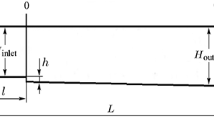Abstract
Results are presented of a numerical modeling of the ignition and combustion of underexpanded turbulent hydrogen jets injected into supersonic air flow (M=2.63) along the walls of a two-dimensional duct. Calculations were performed by numerical integration of reduced Navier-Stokes equations using the method of global iterations. The kinetic mechanism of hydrogen combustion in air involved 13 reactions. In the calculations the duct height was varied. In a fairly narrow duct, the static pressure increased with flow deceleration to subsonic velocities due to ignition and combustion. The influence of combustion on the pressure distribution in the transverse direction is ambiguous. Initially, combustion increases the pressure nonuniformity (a new oblique shock wave occurs), while, downstream, the pressure profile is flattened out due to the appearance of a subsonic layer near the flame front.
Similar content being viewed by others
References
O. M. Kolesnikov, “Effect of off-design on the delay of ignition of a hydrogen jet near the wall in a supersonic flow,”Fiz. Goreniya Vzryva,26, No. 5, 15–19 (1990).
G. D. Power, “A novel approach for analyzing supersonic high Reynolds number flows with separation,” AIAA Paper No. 90-0764 (1990).
E. Spigler, M. Wolfstein, and Y. Manheimer-Timnat, “A model of unmixedness for turbulent reacting flows,”Acta Astronaut.,3, Nos. 3 and 4 (1976).
O. M. Kolesnikov, I. G. Makarov, E. A. Meshcheryakov, and V. A. Sabel'nikov, “Numerical modeling of supersonic combustion of hydrogen,” Preprint No. 63, Central Aerohydrodynamic Institute, Zhukovskii (1992).
Y. C. Vigneron, J. V. Rakich, and J. C. Tannehill, “Calculation of supersonic viscous flows over delta wings with sharp subsonic leading edge,” AIAA Paper No. 78-1137 (1978).
M. Barnett and G. D. Power, “An efficient algorithm for strong viscous/inviscid interaction in hypersonic flows,” AIAA Paper No. 88-0712 (1988).
G. D. Reyhner and A. Flugge-Lotz, “The interaction of a shock wave with laminar boundary layer,”Int. J. Non-Linear Mech.,3, 173–179 (1968).
M. C. Burrows and A. P. Kurkov, “Supersonic combustion of hydrogen in a vitiated air stream using stepped-wall injection,” AIAA Paper No. 71-721 (1971).
Author information
Authors and Affiliations
Additional information
Translated from Fizika Goreniya i Vzryva, Vol. 32, No. 4, pp. 47–54, July–August, 1996.
Rights and permissions
About this article
Cite this article
Kolesnikov, O.M. Numerical modeling of supersonic-flow deceleration in a two-dimensional duct in combustion of wall tangential hydrogen jets. Combust Explos Shock Waves 32, 399–405 (1996). https://doi.org/10.1007/BF01998486
Received:
Revised:
Issue Date:
DOI: https://doi.org/10.1007/BF01998486



